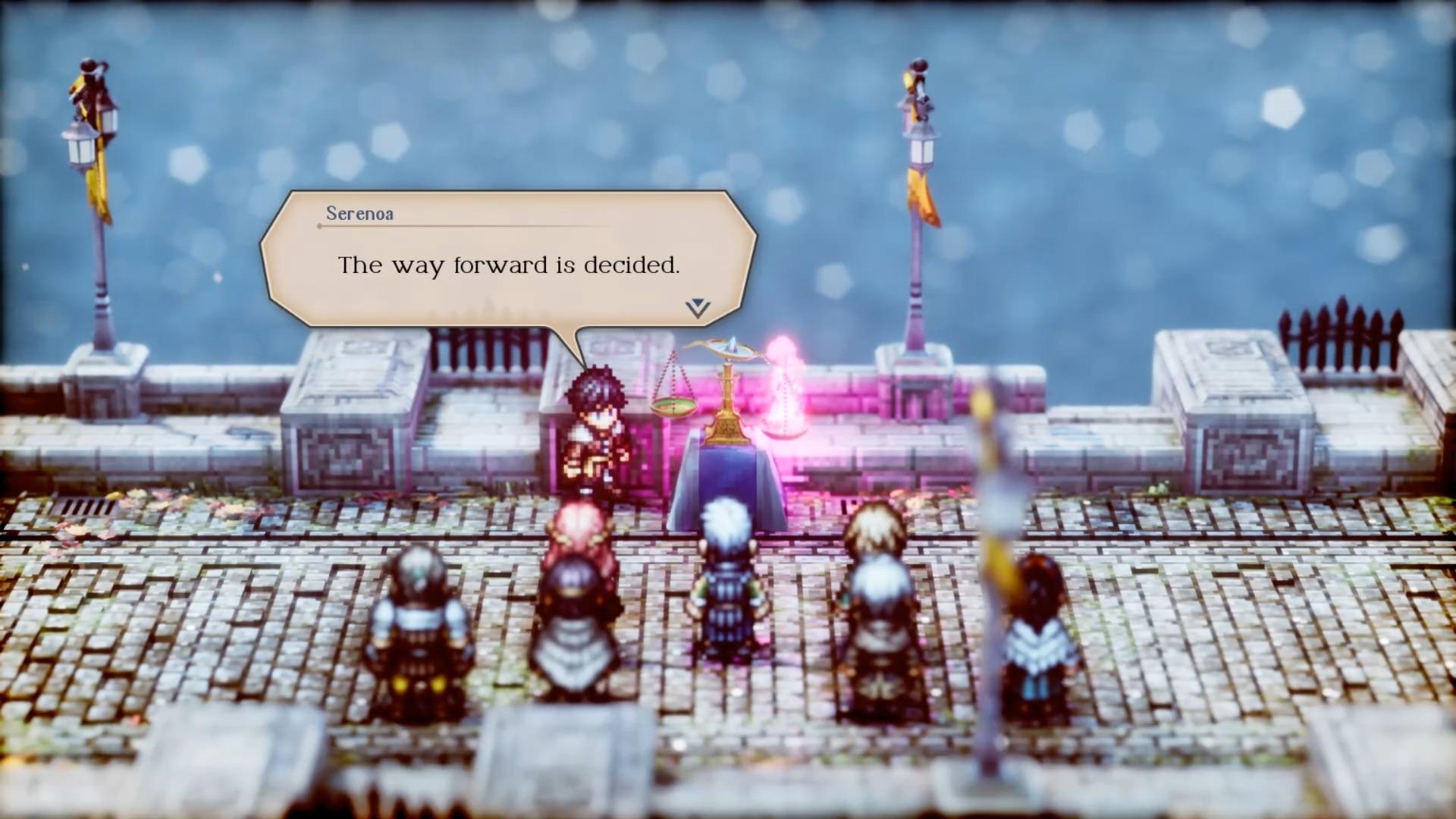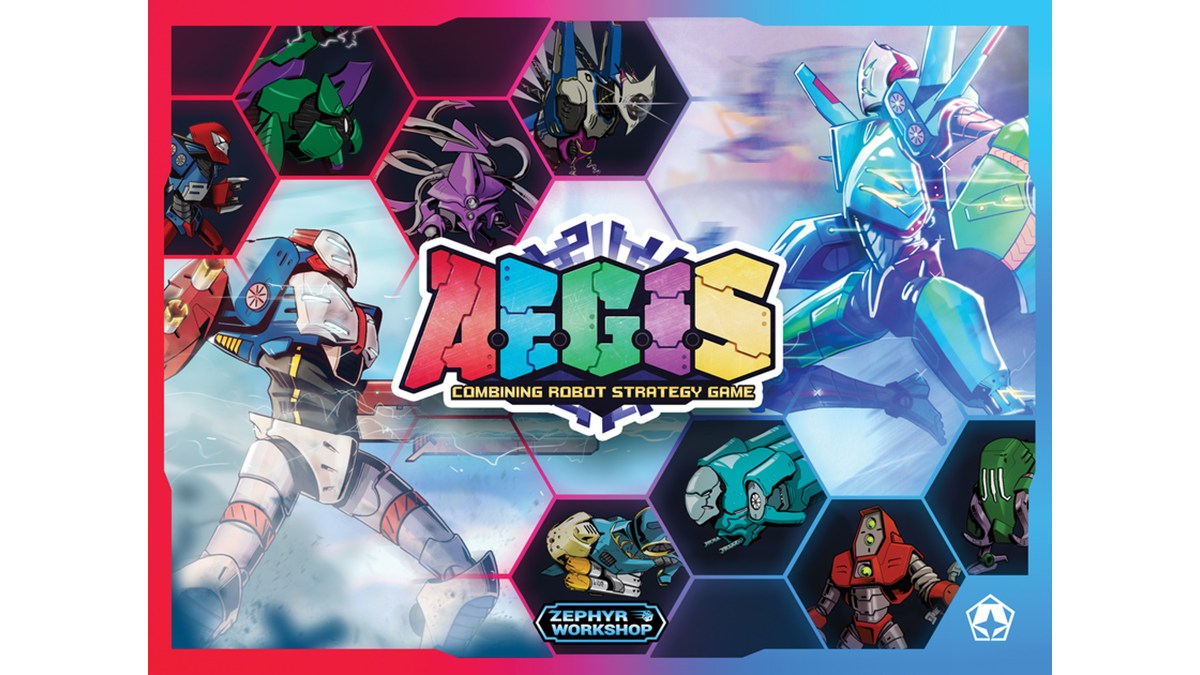While the Advance Wars and Fire Emblem series kicked off my love affair with turn-based strategy gaming, it was another Game Boy Advance title, 2003’s RPG-heavy Final Fantasy Tactics Advance, that truly cemented the genre as a longtime favorite. Even from its earliest reveal, Square Enix’s Triangle Strategy reminded me of FFTA, with its multi-tiered battlegrounds and granular character progression, so I was obviously excited to see my way through two separate demos and, finally, the full game itself.
With the title arriving on retail shelves later this week, I can at last share my thoughts on this new take on the age-old tactics gaming formula, though, in truth, I find myself wanting to insulate my enthusiasm a little, to wrap it in a blanket of vagueness for the sake of those about to take their first step into the land of Norzelia. This is because, while devious political machinations, difficult player choices, and nonstop plot twists are to be expected in this style of game, they are as integral to Triangle Strategy as its battle maps, skill trees, and loot system.
Suffice it to say, as far as this review is concerned, the phrase “spoiler-free” may be a bit of an understatement.
War (What Is It Good For?)
While most tactical titles are content to set themselves at the start of a great war, Triangle Strategy takes a different approach. Beginning some 30 years after the Saltiron War that divided the continent of Norzelia, it instead picks up in a time of relative peace.
The three great Norzelian kingdoms—Glenbrook, Aesfrost, and Hyzante—seem to have put at least some of their lingering differences aside, and have recently launched a joint mining operation in the heart of Glenbrook. Of course, events early in the game threaten this tentative harmony, and the mine itself becomes a flashpoint for another grand international incident.
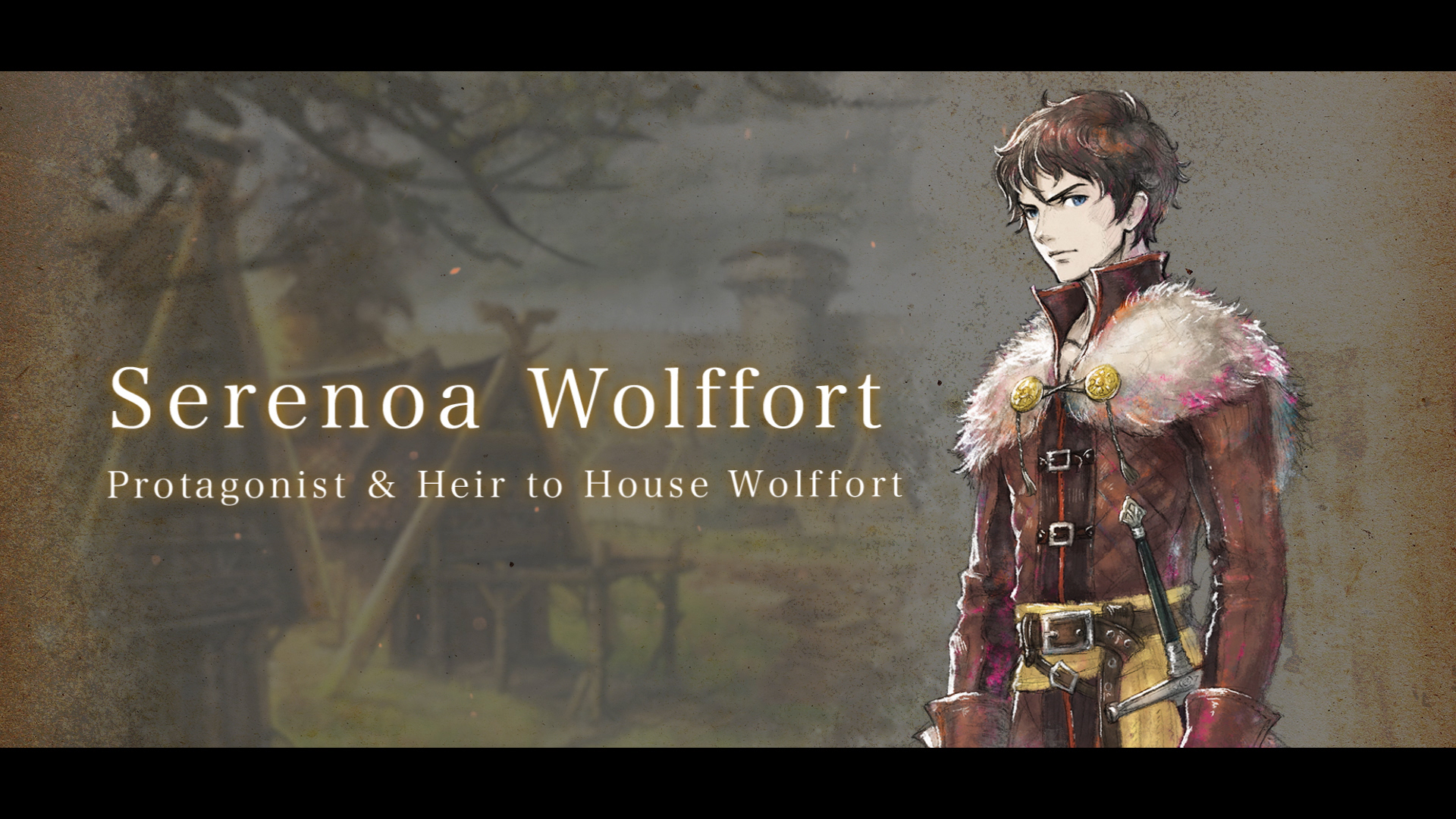
Your primary protagonist, Serenoa, is the heir of House Wolffort, one of the three great houses of the largely agricultural Glenbrook. Loyal to their king to a fault and seemingly devoted to righting the wrongs of the past, Glenbrook is hampered by the trappings of the classical hereditary monarchy. In fact, one of the game’s earliest developments concerns Serenoa’s arranged marriage to Princess Frederica Aesfrost. This union of minor nobles is engineered to help unite the two nations without providing either party too much political clout.
The half-sister of archduke Gustadolph Aesfrost, Frederica was born of a Rosellan concubine—a pink-haired ethnic group viewed, at best, as second-class citizens—making her the lesser of her siblings and perfect for a half-hearted show of transnational unity. Though seemingly a meritocracy where freedom is paramount, the Grand Duchy of Aesfrost is just as concerned with bloodlines as any other kingdom, and the readily available supply of iron in their inhospitable domain has given their military a distinct advantage, resulting in a harsh and warlike culture.
Rounding out the trio is the Holy State of Hyzante, the spiritual seat of the continent and home of its singular supply of salt. Though touted as the very blessing of the Goddess meant to be shared with all faithful believers, this salt is heavily regulated and highly taxed, making it available to only the richest and most influential citizens. Ruled by the mysterious Hierophant and a powerful but corrupt ministry known as the Saintly Seven, Hyzante’s religious fervor is used as justification for the continued enslavement of the native Rosellan population who must toil in the salt lake (known as the Goddess’ Shield) to provide the kingdom with its most valuable export.
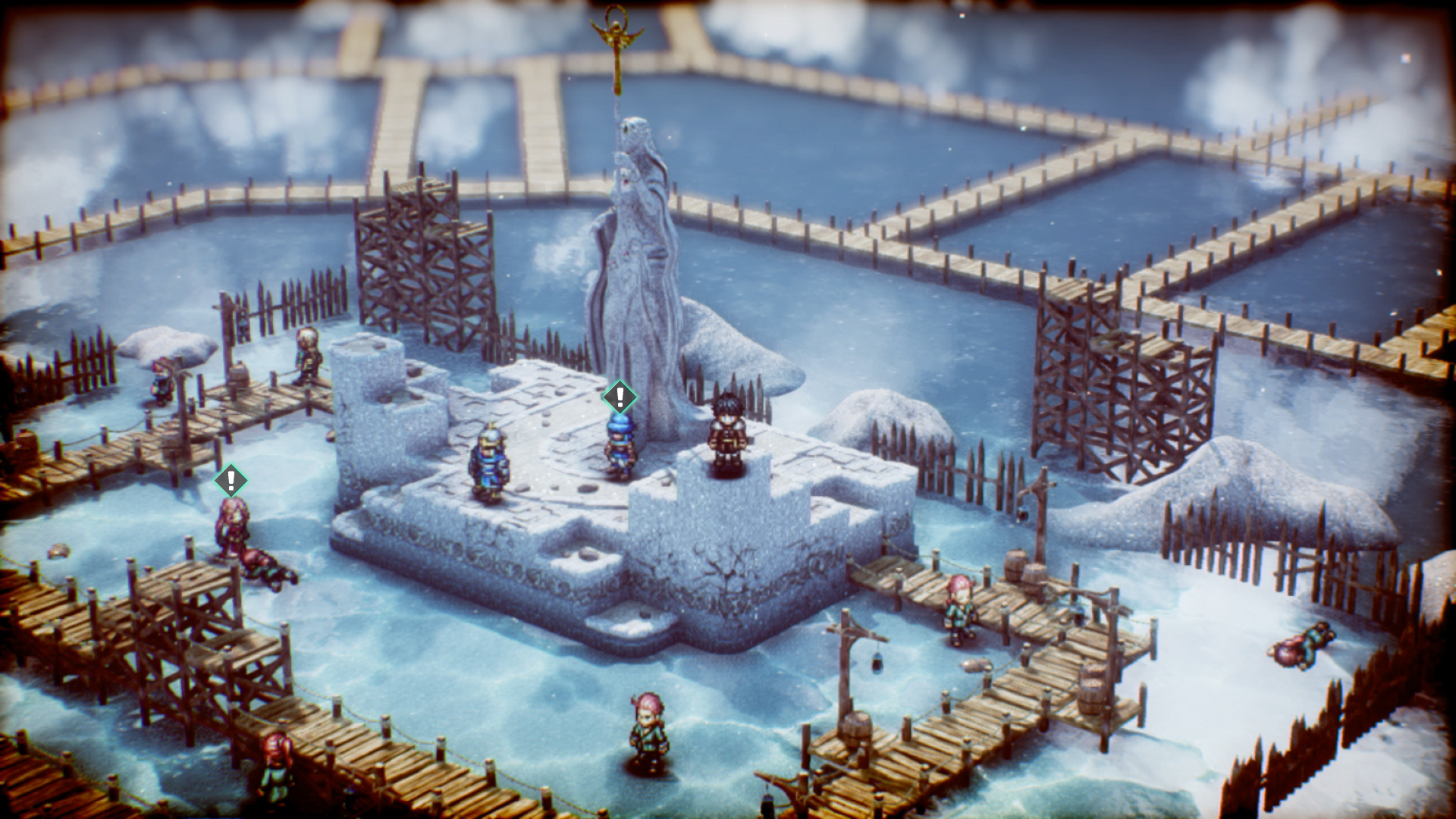
These three great but obviously flawed nations provide an ample backdrop of Triangle Strategy‘s inspired storytelling, and even in its earliest chapters, the decisions you make help shape your adventure and your world. From harmony to conflict, companionship to betrayal, your words and actions have genuine weight in the unfolding narrative.
The Threefold Path
While it may be a turn-off to more action-oriented gamers, I found the story-heavy Triangle Strategy to be a real treat in part because of the way it seems so clearly designed to continually challenge the beliefs of Serenoa and his party. At nearly every turn, from pitched interactions with foes to seemingly off-hand comments to townsfolk, the game often takes you to task.
Think of its as a playable Rorschach test that asks at every turn whether you value utility, morality, or liberty the most—with the answers and their repercussions usually anything but cut and dry.
After only a couple of hours of gameplay, I came to greet the little text bug in the upper-right corner telling me that Serenoa’s convictions had been strengthened with an almost visceral response. My mind would reel. Had I made the moral choice? Had I presented myself with honor? Was I thinking of the good of my kingdom and countrymen, or was I only concerned with myself, my friends, and my pyromancer bride?
Thankfully, the choices were never mine alone.
Democracy in Action
While the core gameplay mechanics—which I’ll get to in a moment, I swear—and even the high fantasy political trappings of Triangle Strategy are far from unheard of in the genre, there’s a novel element that really sets this title apart: the Scales of Conviction.
At the start of the game, you are entrusted with seven coins that you, in turn, give to your most trusted allies and advisors. At crucial points in the game, these parties will weigh their opinions on the Scales of Conviction to determine the path forward.
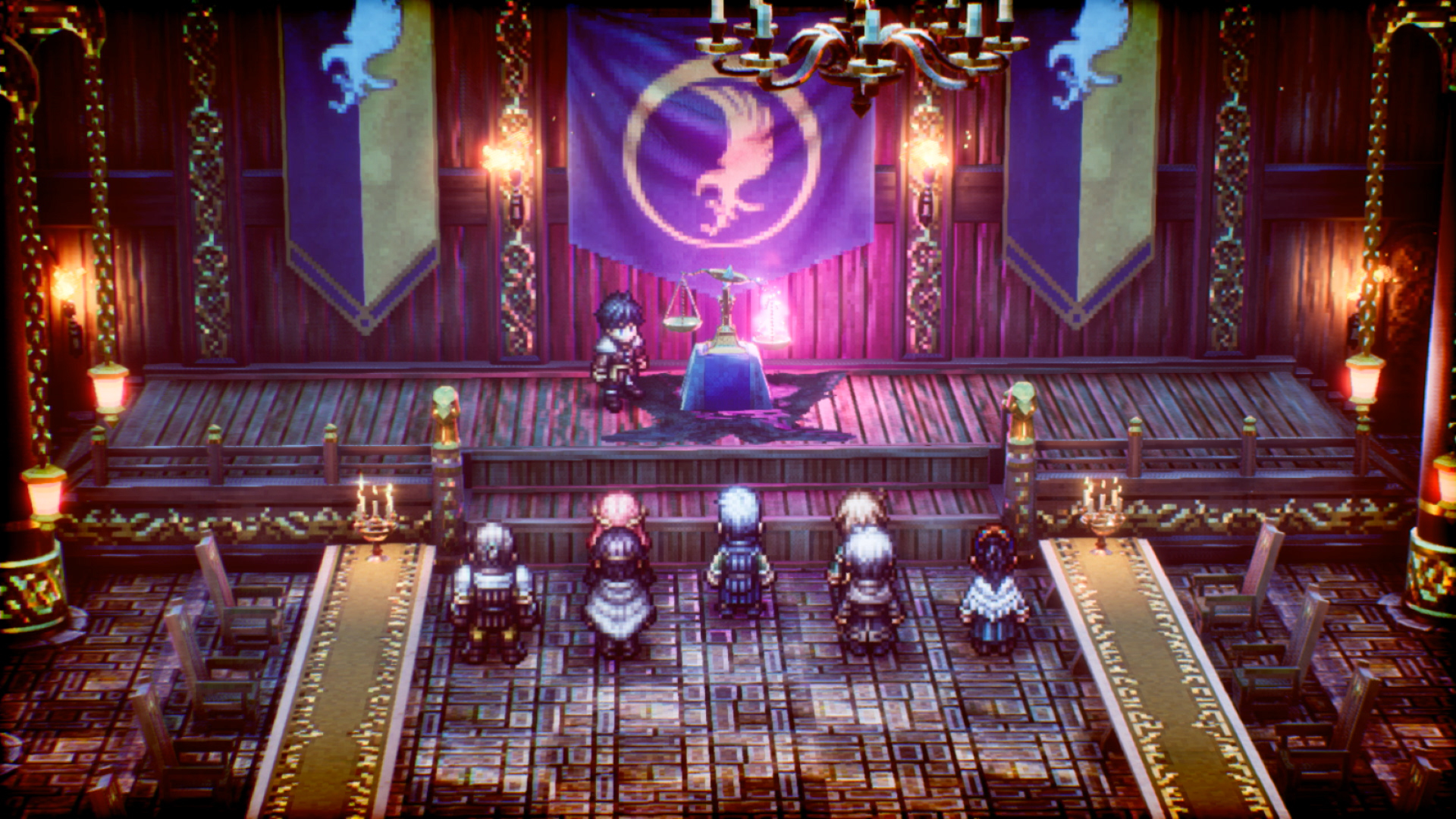
While their own personalities and backgrounds come into play, Serenoa does have the opportunity to speak with each of them one on one and attempt to either strengthen their convictions or change their minds. Yet, to do this effectively, you must take a global, holistic view of the unfolding conflict.
This is done, in part, using the world map, where required missions are shown in red and optional story missions in green. While the former powers the plot and inevitably leads to those sweet, sweet turn-based battles, the latter can provide helpful windows into behind-the-scenes events that can truly help inform your decision.
Before the deliberation and vote, Serenoa is also generally allowed to leave the chamber, ostensibly to clear his head, but you’ll quickly realize that just chatting with the locals is a wonderful way to gather intel. This can even help unlock additional dialog options with your party members that further help shape their opinions.
On a number of occasions, I actually found myself playing devil’s advocate with allies I agreed with just to see if, by providing them a clearer picture of the situation, they could provide me with better council.
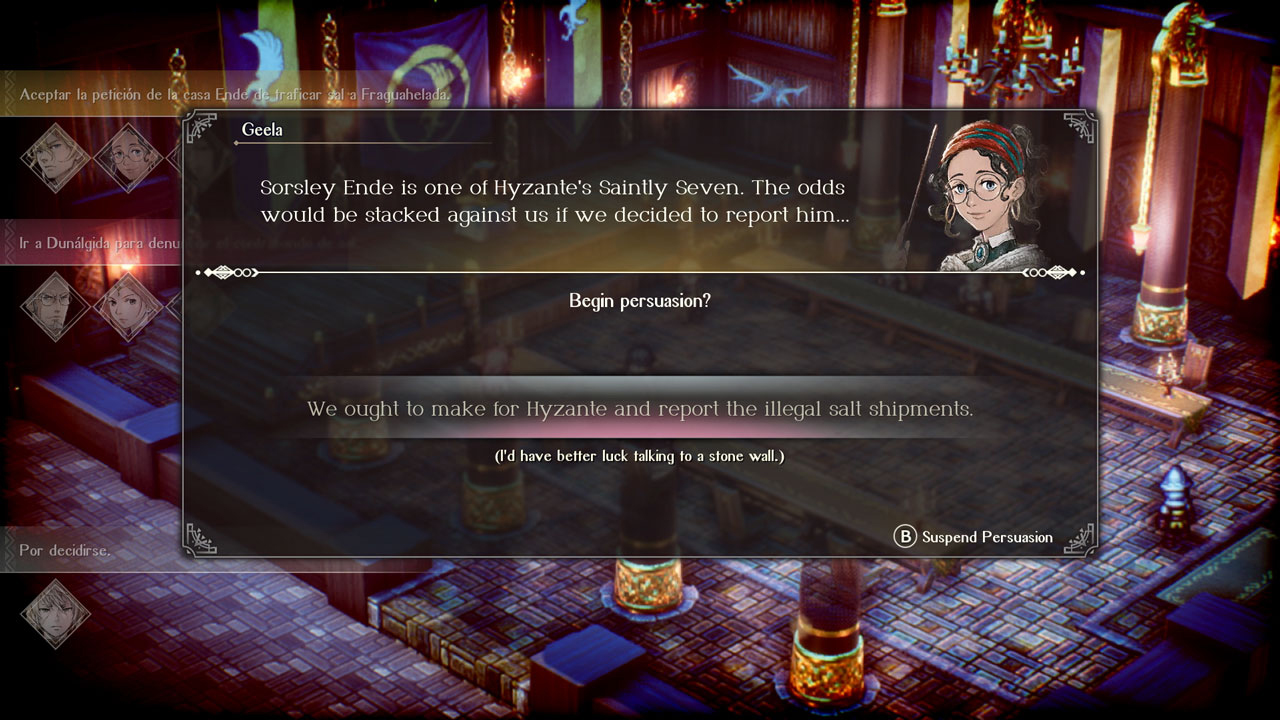
Even more than your performance on the battlefield, these voting sessions help shape the various branching paths (and requisite multiple endings) that make Triangle Strategy such a compelling experience.
The Art of War
Ok, now that I’ve belabored the delicate socio-political point at the heart of the game, let’s turn our attention to kicking ass on the battlefield. (And, oh, the asses you will kick!)
From urban warfare to delicate operations in foreign lands to front-line battles, this game has it all—and backing it up is a wonderfully varied collection of warrior-allies that help keep the fighting fun and frantic.
Unsurprisingly, Serenoa Wollfort leads from the front with a sword in hand, but he’s ably backed up by a growing military force including cavalry (his best friend and King Regna’s unfavored son, Roland Glenbrook), assassins (the ninja-like Anna Pascal, who’s sure to be a fan-favorite), and magic-users (like Frederica and her attendant Geela Breisse). In addition to unlocking new and more powerful attacks and steadily increasing their core stats as they level up, Serenoa and his allies also have unique movement types, making certain allies more maneuverable on certain terrain.

Flying archer Hughette is great at moving across hills and rooftops, while Roland, on horseback, is not. This obviously plays a part in unit deployment, and the game makes it very easy to survey battlefield environments to see who may be the better fit. It will even suggest certain party members for specific battles.
Battlefield positioning is key as, in shades of Final Fantasy Tactics, backstab attacks inflict higher damage. You can even surround a common enemy on two sides, enabling a follow-up attack from the nearby ally, to help whittle down those pesky HP. Attacking from a higher elevation also has its advantages. (Take that, Anakin Skywalker!)
Turn order is displayed at the bottom of the battle screen, and on a turn, a character can move and take a number of actions equal to their tactical points. Abilities each have a TP value next to them to let you know how many points are required, and, using the Weapon Upgrade system at the Encampment, your mobile base of operation, you can even spend resources to reduce the TP cost of some skills (along with unlocking passive skills and increasing weapon/magic damage).
The needed resources can be purchased from merchants, but the higher quality goods are often gained as spoils during a battle. If a defeated enemy drops a bag of loot, just end an ally turn on that location to claim those spoils for use at the Encampment.
Special items can also be used at your Encampment to promote characters to higher classes, but there’s so more that can be accomplished under this big tent. Perhaps most interestingly, Hossabara the barkeep will routinely unlock new mental mock battles, practice exercises that help you master new tactics, gain valuable experience, and even rack up more of those valuable spoils.
Leave It All on the Field
Interestingly, Triangle Strategy doesn’t really have anything with regard to cinematic cutscenes. Most expository dialog plays out in-engine using the three-quarter isometric “HD-2D” graphical style (a la Octopath Traveler), with the occasional map voice-over to set the stage between chapters.
The voice acting, I must point out, is really top-shelf. In addition to our omniscient narrator, all the principal cast is voiced at one time or another, and a steady trickle of new party members (they turn up in and around your Encampment throughout the game depending on your narrative path) never seems overwhelming in part because each has such a strong, distinct personality.
I think it’s because of this reliance on in-engine storytelling that I never once felt pulled out of the game. Even when I was seeing scenes and events that Serenoa obviously could not watch unfold, it still seemed like a continuous, sustained story—and one that rewarded my attention rather than trying my patience by cramming too much exposition into sustained animated cutscenes.
The Tactics RPG Elevated
Triangle Strategy doesn’t exactly reinvent the wheel when it comes to tactical RPGs, but what it does do is improve upon that wheel—maybe by adding a road-hugging, low-profile tire and a handsome titanium rim. As previously mentioned, the overall look and feel is very much in the Final Fantasy Tactics vein, while the focus on story and interpersonal relationships will seem comfortably familiar to fans of the Fire Emblem franchise (especially the stellar Three Houses).
Little tweaks like the Quietus system—think of them as unlockable acts of god that you can pull out in a pitched battle—and kudos—a sort of specialized secondary currency tied to battlefield achievements that can be used to purchase, among other resources, new Quietuses—go a long way in refining an already well-implemented level and class promotion mechanic. But the game’s biggest successes are steeped in its sheer dedication to constancy. From its coherent visual representation to its always evocative soundtrack, its solid pacing to its deep, engaging plot, Triangle Strategy absolutely understands what it is, and the game is all the better for it.

Clearly, its C-SPAN meets Game of Thrones blend of politics and intrigue aren’t for everyone, and, unlike Three Houses, I’m not sure this one will convert any tactics naysayers into diehard believers. Yet, for those of us who already appreciate this still fairly niche genre, Triangle Strategy is another outstanding addition to the Nintendo Switch library.
Now, if only they’d done something about that unimaginative title…
Seriously, though, even if this type of game doesn’t necessarily seem like your jam, I’d urge you to at least download the free Triangle Strategy demo from the Nintendo eShop. It does a phenomenal job of frontloading just enough of the story to let you hit the ground running. Plus, should you decide to purchase the full title, you can import your save data and pick right up where the demo leaves off—a feature I’d love to see in more demo offerings, especially for massive RPG adventures like this one.
Review materials provided by Nintendo of America. This post contains affiliate links. Who knew trade disputes and religious fervor could make for such a compelling gameplay experience?!
